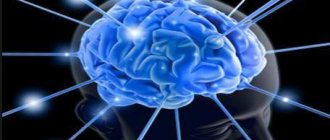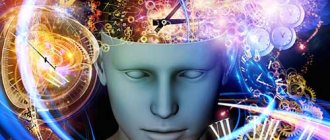Consciousness
The problem of consciousness has always attracted the close attention of philosophers, because determining the place and role of man in the world, the specifics of his relationship with the reality around him presupposes clarification of the nature of human consciousness.
For philosophy, this problem is also important because certain approaches to the question of the essence of consciousness, the nature of its relationship to being, affect the initial ideological and methodological guidelines of any philosophical direction. Consciousness is a key, initial philosophical concept for the analysis of all forms of manifestation of a person’s spiritual and mental life in their unity and integrity, as well as ways to control and regulate his relationships with reality, and manage these relationships.
A common problem of all philosophical directions:
- analysis of consciousness as a specifically human form of regulation and control of human interaction with reality.
This form is characterized primarily by the identification of a person as a unique reality, as a bearer of special ways of interacting with the surrounding world, including managing it.
Such an understanding of the nature of consciousness presupposes a very wide range of issues, which becomes the subject of research not only in philosophy, but also in special humanities and natural sciences: sociology, psychology, linguistics, pedagogy, physiology of higher nervous activity, and now semiotics, cybernetics, computer science. Acute and topical issues of modern social development, interaction between man and technology, the relationship between scientific and technological progress and nature, problems of education, communication between people, etc., all problems of modern social practice turn out to be organically related to the study of consciousness.
The most important philosophical question has always been and remains:
- about the relationship of human consciousness to his existence;
- about the inclusion of a person with consciousness in the world;
- about the possibilities that consciousness provides to a person;
- about the responsibility that consciousness imposes on a person.
The existence of a person in the world is always connected with consciousness; there is no human existence without consciousness, independent of one or another of its forms. In the context of human activity as an integral system, consciousness is its necessary condition, prerequisite, element. The ideal plans of activity, its programs and projects developed by consciousness precede activity, but their implementation reveals new “unprogrammed” layers of reality, opens up a new texture of being, which goes beyond the initial settings of consciousness. In this sense, human existence constantly goes beyond the limits of consciousness as an ideal plan, a program of action, and turns out to be richer in the content of the initial ideas of consciousness. At the same time, this expansion of the “existential horizon” is carried out in activity stimulated and directed by consciousness.
If we proceed from the organic inclusion of man in the integrity of inanimate and living nature, then consciousness appears as a property of highly organized matter. Hence the need arises to trace the genetic origins of consciousness in those forms of organization of matter that precede man in the process of his evolution. The most important prerequisite for this approach is the analysis of the types of relationships of living beings to the environment, within which corresponding regulators of behavior arise as their “service mechanisms”. The development of the latter involves the formation of bodily organs, thanks to which the processes of the psyche and consciousness are carried out - the nervous system and its most highly organized department - the brain. However, the determining factor in the development of these bodily organs is the actual life function for which these organs work. A person is conscious with the help of the brain, but consciousness is not a function of the brain in itself, but a function of a certain, specific type of relationship between a socially developed person and the world.
Given this premise, consciousness is a social product from the very beginning. It arises and develops in the joint activity of people, in the process of their work and communication. By getting involved in these processes, people develop appropriate ideas, attitudes, and norms, which, together with their emotional coloring, constitute the content of consciousness as a specific form of reflection. This content is fixed in their individual psyche.
Consciousness is the ability to ideally reproduce reality in thinking. Consciousness performs the function of the social memory of humanity, developing certain schemes for reproducing the experience accumulated by humanity. The emergence and development of consciousness is inextricably linked with the development of language as the material embodiment of the norms of consciousness.
Forms of consciousness:
- individual (personal);
- public.
Social consciousness is a reflection of social existence; forms of social consciousness - science, philosophy, art, morality, religion, politics, etc.
List of references and other sources of information
1. Godefroy J. What is psychology: trans. from fr. M.: Mir, 1996
2. Kulikov L. V. Psychology of consciousness St. Petersburg: Peter, 2001
3. Luria A.R. Lectures on general psychology. - St. Petersburg: 2004.
4. Mironov V.V. Philosophy. Textbook for universities M. 2011
5. Nemov R.S. Psychology - M. 1998.
6. [Electronic resource]: https://psychology.academic.ru/ (electronic psychological encyclopedia)
7. [Electronic resource]: https://platonanet.org.ua/ (brief philosophical dictionary)
Attention!
If you need help writing a paper, we recommend turning to professionals. More than 70,000 authors are ready to help you right now. Free adjustments and improvements. Find out the cost of your work
Free estimate
+1
Size: 18.75K
Downloads: 104
11/14/14 at 02:08 pm Author: MaryDarkness
Liked? Click on the button below. It's not difficult for you
, and we
are pleased
).
To download test papers for free at maximum speed, register or log in to the site.
Important! All submitted Tests for free downloading are intended for drawing up a plan or basis for your own scientific works.
Friends! You have a unique opportunity to help students just like you! If our site helped you find the job you need, then you certainly understand how the job you add can make the work of others easier.
Add a job
If the Test work, in your opinion, is of poor quality, or you have already seen this work, please let us know.
Self-awareness
Of course, the idea of self-consciousness should also be associated with consciousness in the broad sense of the word.
Self-consciousness is an essential moment of consciousness, expressing the actual reality of consciousness to the subject, the image of oneself and the attitude towards oneself. Self-awareness includes a person’s understanding and assessment of his knowledge, moral character and interests, motives of behavior and ideals, a holistic assessment of himself as a feeling, thinking and active being.
Civic consciousness (for comparison)
Civic consciousness (all-Russian civic identity) is the awareness by citizens of the Russian Federation of their belonging to their state, people, society, responsibility for the fate of the country, the need to respect civil rights and obligations, as well as commitment to the basic values of Russian society.
See Decree of the President of the Russian Federation dated December 6, 2018 N 703 “On amendments to the Strategy of the State National Policy of the Russian Federation for the period until 2025, approved by Decree of the President of the Russian Federation dated December 19, 2012 N 1666”
The main functions of self-awareness (according to M. L. Tkacheva):
- self-knowledge;
- self improvement;
- the search for the meaning of life as a result of the search for the meaning of real activity.
Self-awareness cannot be separated from a person’s social environment, his lifestyle and activities, which require him to self-control his actions and take responsibility for them. In this case, self-awareness, at its deepest level, is initially social in nature.
A more specific analysis of self-awareness turns out that scientists and philosophers do not agree on its explanation.
Approaches to the problem of self-awareness (depending on the time of appearance of self-awareness in a person’s personal existence):
- Self-awareness in its simplest form consists of a vague sense of one's own existence. Consequently, the simplest self-awareness in the development of a child precedes consciousness, i.e. clear and distinct representations of objects (V.M. Bekhterev - Russian researcher of higher nervous activity, founder of the school of reflexology).
- Consciousness and self-awareness arise simultaneously, although not immediately, from birth, but as they master their own body, in the process of transforming ordinary actions into voluntary ones (those that are performed thanks to the volitional efforts of the individual). Sensations caused by external objects are always mixed with sensations from the body’s own activity (I.M. Sechenov - the founder of the Russian physiological school).
- Self-awareness is a stage in the development of consciousness, prepared by the development of speech and voluntary movements, the growth of independence caused by this development, and changes in relationships with others. This stage corresponds to the age of two to three years, when the child masters speech and makes attempts to act independently (Soviet psychologists L.S. Vygotsky and S.L. Rubinstein).
- The emergence of self-awareness as a process of subjective separation from the mother: discomfort caused by natural bodily states and functions (hunger, cold, etc.) decreases in the child with the appearance of the mother. As a result, he begins to single out his mother in the world, and to separate himself from her (representatives of the psychoanalytic approach are S. Freud and his followers).
More details
There is no point in criticizing these approaches, because each of them examines one or more actually existing relationships and mental processes. It is probably more appropriate to identify the stages of formation of self-awareness and trace the sequence of their development.
All events occurring in the visible and internal life of an individual imply differentiation (separation) of a person from the social environment (primarily family) and identification (identification, likening to the most significant individuals from this environment as models of behavior, thinking and experience). Identification and differentiation act as mutually opposite tendencies, forming an internally contradictory unity in the formation of an individual’s self-awareness.
If we interpret the process of development of self-knowledge as the self-separation of the subject from the environment, then its first stage should be considered the separation of the image of objects from the image of one’s own body, its motor activity, the position of the body in space, and the sensation of internal organs. Similarly, the human individual forms an image of himself. The fundamental difference between this process lies in its social rather than biological nature: a person acts, inevitably getting to know himself in the same way as he gets to know his environment.
But the action itself becomes possible only insofar as the individual forms an idea of himself commensurate with his social existence. Such a representation includes, firstly, the subject’s acquisition of the ability to imagine his appearance as others see it, and secondly, the ability to evaluate himself according to the models (measures) of other people. In both cases, the expression “taking another’s point of view on oneself” is used. Its meaning is that from the very moment of birth a person becomes the object of the relationship of another person, primarily parents. The attitude towards the child precedes his self-attitude, the consciousness of him by others precedes his self-awareness. In this case, self-consciousness is a transformed and transferred into the inner world of a person’s point of view of him as a subject. The transformed point of view of others is for a person a “generalized, generalized other,” the embodiment of social norms internalized by a person. The transition of social norms into the inner world of the individual occurs in the process of communication and joint activity with other people, and a person’s self-awareness acts as an appropriated, transferred into the inner world of a person’s awareness of him by others.
The first step in accepting another's point of view is acquiring the ability to recognize oneself in the mirror. It is known that this does not happen immediately, but at a certain age, and the moment of such recognition can be interpreted as evidence of the emergence of self-awareness. To recognize oneself in the mirror means to develop the ability to identify one's appearance, as seen by others, with oneself; such recognition presupposes the assimilation of a different point of view, external to the subject. In adults, this ability becomes automatic. For example, if you ask a person to place an image of the letter “E” on his forehead, then without prior instructions he will position it so that an imaginary observer facing him can read it correctly. At the same time, a person’s idea of himself does not completely coincide with the point of view of others and with the objective properties of his body. Thus, experiments with a mirror in which one can “expand” or “narrow” the image have shown that self-correction of a figure almost never coincides with the “correct”, undistorted reflection, but turns out to depend on a person’s self-esteem, the degree of his self-esteem and other social factors.
Another aspect of accepting the point of view of another relates to the emergence of the ability to evaluate oneself, to form an attitude towards oneself, based on the attitude of parents as a social group in which primary socialization takes place. Types of parent-child relationships were identified (“love-hostility”, “independence-control”); different forms of the child’s reactions to parental behavior (“additional” - showing initiative in response to the provision of independence, “defensive” - love in response to hostility); the dependence of “adult” behavior on children’s experience of communicating with parents. Thus, according to the content of the acquired primary social experience, one can isolate: values, norms as standards of behavior and norms-examples, a “scale” of assessments and self-esteem; self-image as a bearer of certain abilities and qualities; attitude towards oneself, emotional and intellectual assessment of oneself; someone else's self-esteem; introjection (transfer inside) of a way of regulating a person’s behavior by parents and other adults.
A very important point in the development of self-awareness is the emotional component of the meaning of “I”. Emotions are experiences that reflect a person’s own attitude to what she knows, understands, “discovers” about herself, that is, her various self-attitudes. Emotion acts as a way of clarifying and establishing a person’s value for himself. The emotional component of the “I” includes diverse and non-one-dimensional processes that affect the most important types of relationships for a person with others. Just like other elements of self-awareness, they develop in and through the process of communication; the development of feelings also goes from inter-(interpersonal) to intrapsychic (intrapersonal) function. First, the child perceives the feelings of other people (primarily close relatives), and in communication he assimilates the very structure of feeling.
This primacy of interpersonal relationships in the formation of the emotional component of self-awareness allows us to study the emotional-value component of self-awareness based on a person’s emotional attitude towards another person. The well-known “golden rule” of morality (“act as you want others to act towards you”) can and should be inverted: you act towards yourself in the same way as you behave towards others. On the other hand, a person’s attitude towards himself is mediated by the attitude of another person towards a person and is built on the principles of the oppositions of sympathy-antipathy, respect-disrespect, closeness-distance. Thus, self-awareness is three-voiced: it involves an experienced attitude towards oneself, an attitude towards another person and a perceived (or expected) attitude of another.
From the point of view of the effectiveness of an individual’s assimilation of social forms of activity and social meanings, such an aspect of self-awareness as the internalization (“internalization”) of elements of the social structure, culminating in the formation of a “self-model”, an integral self-characteristic of the individual, containing the most preferred, ideal character traits, physical and emotional appearance. This process also lies between the poles of identification and differentiation. Its essence lies not only in the acceptance of certain social-role responsibilities as “suitable” for characterizing a person, but also in finding within the individual the potential and incentives for the successful implementation of social activities prescribed by these roles, as well as in self-approval of the chosen strategy of behavior and activity .
In real life, self-consciousness is an extremely complex structure, the individual elements and systems of which are not so much in a state of harmony as in conflict and contradictions, which are designated as “multiplicity of meanings of “I”, “conflict of meanings of “I”, “conflict of intrapersonal dialogue” . The generating cause of these conflicts is the multiplicity of objectively contradictory forms of activity in which the individual is included.
Identification of oneself, attitude towards oneself, assessment of one’s capabilities, which are a necessary component of any consciousness, form different forms of that specific characteristic of a person, which is called self-awareness.
Self-awareness is a dynamic, historically developing formation that appears at different levels and in different forms:
- well-being - an elementary awareness of one’s body and its fit into the world of surrounding things and people;
- awareness of oneself as belonging to a particular human community, a particular culture and social group;
- the emergence of the consciousness of the Self as a completely special formation, similar to the Self of other people and at the same time unique and inimitable in some way, capable of performing free actions and being responsible for them, which necessarily presupposes the possibility of control over one’s actions and their evaluation.
Self-esteem
Self-esteem is an individual’s opinion about himself, his assessment of his own qualities, strengths and weaknesses, which is based on comparing himself with other people. Unlike self-awareness, self-esteem always involves evaluation, comparison, juxtaposition, and the presence of an outside view of oneself. A person’s self-esteem is an integral part of self-awareness, but self-awareness can exist in its pure form, without self-esteem.
Psychologists distinguish three main types of personality self-esteem:
- Suspended self-esteem is a person’s biased ideas about himself, assessing only his own merits and actually ignoring his shortcomings. On the one hand, high self-esteem gives an individual self-confidence, helps him achieve his goals and objectives (after all, the more faith a person has in his own abilities, the more strong-willed and purposeful he becomes). On the other hand, an inflated level of self-esteem does not allow a person to develop, because people, confident that they know and can do everything, stop learning from others, thus, they begin to gradually degrade.
- Low self-esteem is an individual’s distorted perception of himself, due to which he cannot see his own merits and focuses only on his shortcomings. In this case, the influence of self-esteem has an even more detrimental effect on personality development than in the case of inflated self-esteem. An individual with low self-esteem experiences discomfort in communicating with others (after all, he constantly compares himself with others and finds that he is much worse than others), feels inferior, unworthy, and does not believe in his own strength. People with low self-esteem cannot fully realize their talents and abilities, and are afraid to set high goals for themselves and achieve them.
- Adequate self-esteem is an individual’s objective perception of himself, an assessment of his own strengths and weaknesses that is close to reality. A person with such self-esteem knows that there are people superior to him in qualities, and there are people who have not yet reached the same level of development as himself. In this case, self-confidence cannot become excessive, since the person sees and recognizes his shortcomings and strives to correct them.









